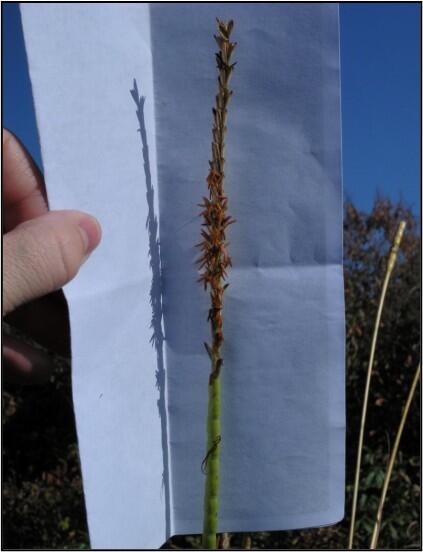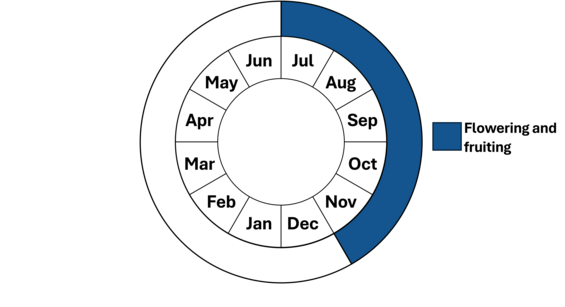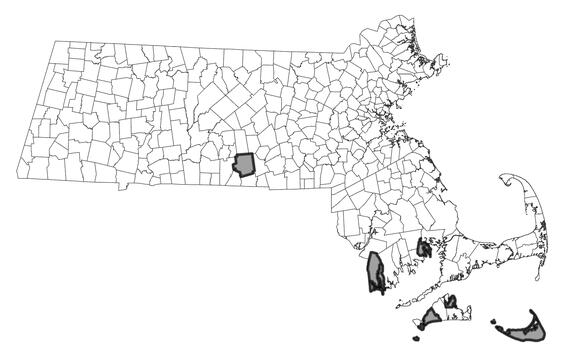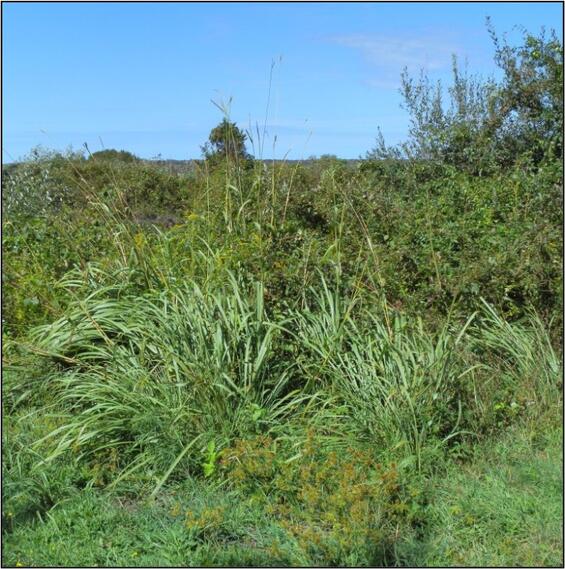- Scientific name: Tripsacum dactyloides
- Species of Greatest Conservation Need (MA State Wildlife Action Plan)
- Endangered (MA Endangered Species Act)
Description

Northern gama-grass is a large, perennial member of the grass family (Poaceae) that is 1-2 m tall (3-7 ft; occasionally up to 4 m [13 ft]). It grows in clumps from stout, knotty rhizomes in sandy-cobble substrates in coastal southern New England. Northern gama-grass is the native species most closely related to maize (Zea mays) and other Teosinte species (Zea spp.), with which it shares many morphological characteristics. It has been used in important evolutionary studies of these grasses. The genus name is derived from the Greek “to rub”, referring to the smooth joints; the species name “with fingers like Dactylon” refers to the finger-like arrangement of rames (flowering spikes). Northern gama-grass is the larval food plant of the owlet moth (Amphipoea erepta ryensis), a species that is critically imperiled globally.
The leaves of northern gama-grass are 9-35 mm (0.35-1.4 in) wide, and 30-75 mm (1.2-3.0 in) long, with scabrous margins. The terminal rames are somewhat digitate. Pistillate spikelets on the lower portions of each rame are 6-8 mm (0.24-0.31 in) long, embedded in the shiny, thickened rame axis. The glumes cover the rachis hollows between the joints, giving the appearance of even thickness to the rame. The staminate spikelets are in sessile to subsessile pairs in the upper portion of the rame. At maturity, the yellow seed-like axes of the pistillate portions break off at the joints.
Other large grass species that may grow near northern gama-grass are switchgrass (Panicum virgatum) and big bluestem (Andropogon gerardii). Switchgrass can be distinguished by its large, open, loosely-branched panicles, ovoid spikelets, and narrower leaves (3-15 mm; 0.12-0.59 in). Big bluestem has 2 to 6 rames that are smaller (5-11 cm; 2.0-4.3 in) than those of northern gama-grass, with most spikelets both pistillate and staminate; it also has white hairs on the rachis, and narrower leaves (5-10 mm; 0.2-0.4 in). Corn (Zea mays), an annual species that occasionally is found growing wild, has axillary pistillate inflorescences and a terminal staminate inflorescence.
Life cycle and behavior

Slender bladderwort is an annual (occasionally perennial) species unlike most other bladderworts in Massachusetts, as it only has its stems with bladders in the substrate rather than floating near the surface of the water. In mid-July to late September, flowering stalks will appear with two to four tiny yellow flowers per stalk (which are insect pollinated). These appear once water has retreated and created an open shoreline at the ponds edge. A single peltate bract (attached in the middle of the bract) is at the base of the flower stalk. Slender bladderwort prolifically produces tiny self-pollinating flowers that do not open. Plants spread both by seeds and vegetatively in the substrate.
Population status
Northern gama-grass is listed under the Massachusetts Endangered Species Act as endangered. All listed species are protected from killing, collecting, possessing, or sale, and from activities that would destroy habitat and thus directly or indirectly cause mortality or disrupt critical behaviors. MassWildlife’s Natural Heritage & Endangered Species Program database has 8 records from 5 counties: Bristol, Dukes, Nantucket, Plymouth, and Worcester. Five of those records are within the last 25-year period.

Distribution and abundance
Northern gama-grass reaches its northern range limit in Massachusetts, Rhode Island, and Connecticut. It is more abundant south of New England, extending south to Florida and west to Michigan, Nebraska, Oklahoma, and Texas; it also occurs in Central and South America.
Habitat

Northern gama-grass is found in open, maritime habitats on sandy-gravelly cobble substrates at the edges of coastal salt ponds, salt marshes, maritime shrublands, and beach strands that are typically wet. It occurs in dynamic maritime habitats, often just above spring tide (highest tide) levels, where plants are exposed to storm surge, wind, and salt spray. Northern gama-grass typically grows in areas with sparse vegetation, often near dunes and salt marshes. Associated species are prairie cordgrass (Spartina pectinata), switchgrass, sea-side goldenrod (Solidago sempervirens), and sea-lavender (Limonium carolinianum). Associated woody species are bayberry (Morella pensylvanica), groundsel-tree (Baccharis halimifolia), eastern red cedar (Juniperus virginiana), beach plum (Prunus maritima), and rose (Rosa spp.). Associated vines include poison ivy (Toxicodendron radicans), fox grape (Vitis labrusca), and Virginia creeper (Parthenocissus quinquefolia). Some locations where northern gama-grass is found are also potential habitat for bristly foxtail (Setaria parviflora), a species listed as Special Concern in Massachusetts.
Healthy habitats are vital for supporting native wildlife and plants. Explore habitats and learn about conservation and restoration in Massachusetts.
Threats
Northern gama-grass inhabits dynamic maritime environments where spring tides or storm surges could destroy populations; these threats may increase as sea level rises in coming decades. The seeds of northern gama-grass are eaten by deer, other mammals, and seed-eating birds, which may limit reproduction from seed. Non-native invasive species may also threaten populations of northern gama-grass. In particular, common reed (Phragmites australis) is a common invasive species that occurs in similar habitats and may outcompete northern gama-grass. Other invasive species known to occur with northern gama-grass include oriental bittersweet (Celastrus orbiculatus) and Morrow's honeysuckle (Lonicera morrowii).
Conservation
Regular monitoring is needed to identify imminent threats to populations in such dynamic habitats. Extant populations should be protected from vehicles and trampling of young plants along paths and edges of shores. Special care is needed when using large equipment for landscaping or other purposes to avoid damage to populations. Monitoring is needed to evaluate these populations. All active management of state-listed plant populations (including invasive species removal) is subject to review under the Massachusetts Endangered Species Act and should be planned in close consultation with the Natural Heritage & Endangered Species Program.
References
deWet, J.M.J. , J.R. Harlan, and D.E. Brink. 1982. Systematics of Tripsacum dactyloides (Gramineae). American Journal of Botany 69: 1251-1257.
Doebley, J.F. 1983. Taxonomy and Evolution of Tripsacum and Teosinte, the Closest Relatives of Maize. Journal Series of the North Carolina Agric. Res. Service. Paper No. 8456, Raleigh, NC.
Flora of North America Editorial Committee, eds. 2003. Flora of North America North of Mexico, Vol. 25. Oxford University Press, NY.
NYNHP Conservation Guide - A Noctuid Moth (Amphipoea erepta ryensis). New York Natural Heritage Program, Albany, NY.
Contact
| Date published: | May 7, 2025 |
|---|